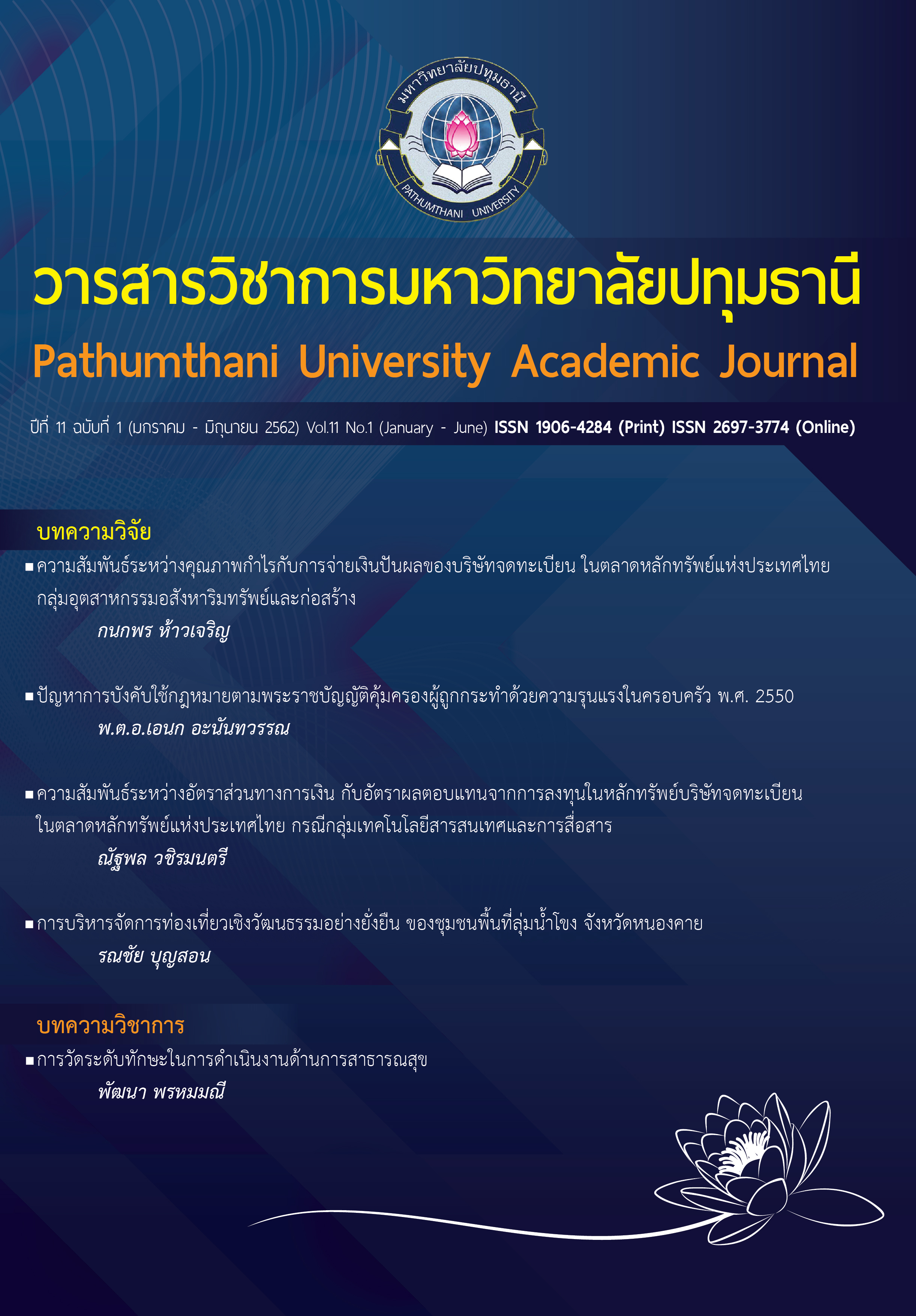Quality of True Wi-Fi Service: A Case Study of Customers in Bangkok
Keywords:
service quality, satisfaction, True Wi-Fi, relationship, behaviorAbstract
The purpose of this independent study was to study the factors affecting the quality of True Wi-Fi service in the view of customers in Bangkok. The studied factors were demographic data and customer’s usage behaviors.
The sample group consisted of 398 customers who used True Wi-Fi service in Bangkok. The instrument used for data collection was questionnaires. Statistics used for data analysis included frequency, percentage, mean, standard deviation, independent samples t-test, one-way ANOVA, and Scheffé’s method of paired comparison.
The result revealed that the majority of the samples were married female age between 21-29 years old. Most of them were employees with the average monthly income of 15,001-20,000 baht and graduated with a bachelor’s degree. According to their behavior analysis, most of them used True Wi-Fi service for less than 1 hour/time. The service was mostly used in the evening (16.00-19.00 hrs.) through smartphones in Phra Khanong District. Besides, they used the service for personal use, and for the social network – LINE. The highest level of satisfaction in the service quality was the signal coverage while the lowest level of was the customer service. It was pointed out that there was a significant difference in the customer’s satisfaction of True Wi-Fi service quality based on their genders, ages, marital statuses, and occupations. Moreover, there was a significant difference in the customer’s satisfaction of True Wi-Fi service quality based on their different usage behaviors – the average daily usage durations, the average daily usages, the places they used the service, and the purposes of usages. This study could be used as recommendations for True Corporations to improve their service quality.
References
ทรูคอร์ปอเรชั่น. บมจ. (2560). บริการ True Wi-Fi. https://www.truecorp.co.th/ TrueWiFi.
ธานินทร์ ศิลป์จารุ. (2555). การวิจัยและวิเคราะห์ข้อมูลทางสถิติด้วย SPSS. พิมพ์ครั้งที่ 11. กรุงเทพฯ : บิสซิเนสอาร์แอนด์ดี.
สำนักงานพัฒนาธุรกรรมทางอิเล็กทรอนิกส์ (องค์การมหาชน) กระทรวงเทคโนโลยีสารสนเทศและการสื่อสาร. (2557). ฉลาดรู้เน็ต 1 ตอน Internet of Things (IoT). กรุงเทพฯ:.
สำนักงานสถิติแห่งชาติ. (2551). พฤติกรรมการใช้อินเตอร์เน็ตและสังคมออนไลน์ในประเทศไทยปี พ.ศ. 2559. สืบค้นเมื่อ 3 มีนาคม 2560 จาก https://service.nso.go.th/nso/nsopublish/ service/servstat.html.
Dominici, Gandolfo., & Guzzo, Rosa. (2010). Customer satisfaction in the hotel industry: A case study from sicily. International Journal of Marketing Studies, Vol. 2 No. 2, pp. 3-12.
Magrath, A.J. (2001). When marketing services 4P’s are not enough. Business Horizons. p. 50.
Parasuraman, A., V. A. Zeithaml And L.L. Berry. (1985). “A Conceptual Model Of Service Quality And Its Implications For Future Research,” Journal Of Marketing. Vol.12 No.25 : 125-136.
Sapre, Anand., & Nagpal, Amit. (2009). Viewer relationship management in Indina news channels: an analysis using 7P’s framework. The Icfai University of Marketing Management, Vol. VIII No. 1, pp. 38-47.
Viulet, Nicoleta-Cristina. (2008). Are your satisfied customers loyal?. Annals of the University of Oradea, Economic Science Series, Vol. 17 Issue. 2, pp. 73-80.
Zeithaml, V. A., Parasuraman, A., & Berry, L. L. (1990). Delivering quality service: Balancing custemer perceptions and expections. New York: Free Press.
Downloads
Published
How to Cite
Issue
Section
License
บทความที่ได้รับการตีพิมพ์เป็นลิขสิทธิ์ของวารสารมหาวิทยาลัยปทุมธานี
ข้อความที่ปรากฎในบทความแต่ละเรื่อง เป็นความคิดเห็นส่วนตัวของผู้เขียน กองบรรณาธิการไม่จำเป็นต้องเห็นด้วยเสมอไป และไม่มีส่วนรับผิดชอบใด ๆ ถือเป็นความรับผิดชอบของผู้เขียนแต่เพียงผู้เดียว



